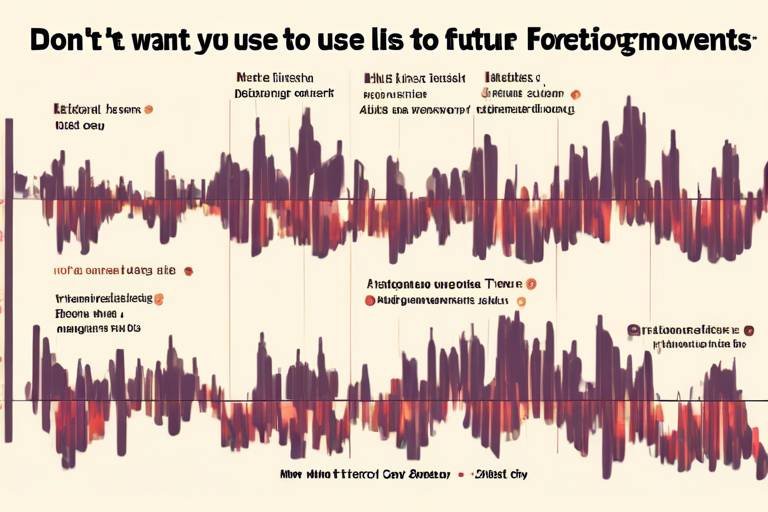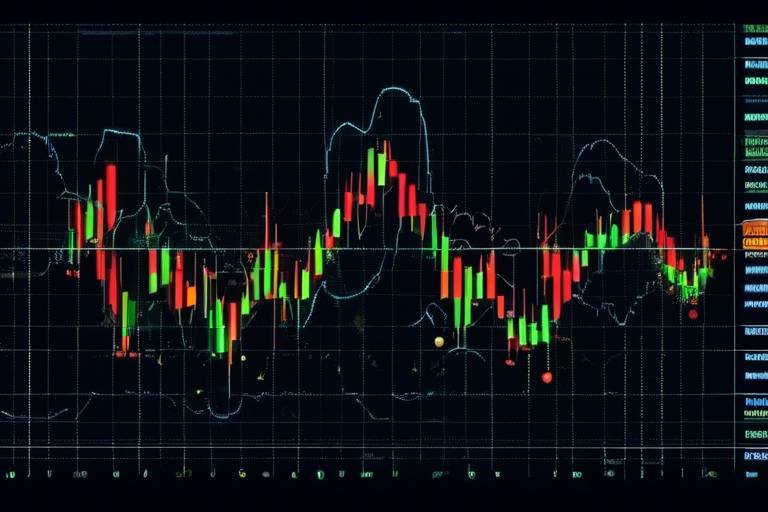The Importance of Timeframes in Technical Analysis
In the world of trading, understanding the importance of timeframes in technical analysis is akin to having a compass in uncharted waters. Timeframes act as the backbone of your trading strategy, guiding your decisions and shaping your market understanding. Whether you're a novice just dipping your toes into the trading pool or a seasoned trader navigating the complexities of the financial markets, recognizing how different timeframes influence your approach can be a game changer.
Imagine timeframes as different lenses through which you can view the market. Each lens offers a unique perspective, revealing insights that can significantly alter your trading strategy. For instance, a short-term trader may focus on minute-by-minute price fluctuations, while a long-term investor might zoom out to observe broader market trends over months or even years. This article will delve into the various timeframes available, their significance, and how they can impact your trading decisions.
Timeframes in technical analysis refer to the specific durations over which price data is analyzed. They can range from mere seconds in the case of scalping to several months or years for long-term investments. Understanding these timeframes is crucial because they help traders identify patterns, make informed decisions, and ultimately enhance their trading performance. The choice of timeframe can affect everything from entry and exit points to risk management and psychological resilience in the face of market volatility.
As we explore the intricacies of timeframes, it becomes clear that selecting the right one is not just a matter of preference; it’s about aligning your trading goals with the appropriate analysis period. This alignment can lead to more effective trading strategies and improved decision-making. So, buckle up as we navigate through the world of short-term versus long-term analysis, exploring the benefits and strategies associated with each.

Understanding Timeframes
Timeframes in technical analysis are the backbone of any trading strategy, acting as the lens through which traders view market movements. They refer to the specific durations over which price data is analyzed, ranging from mere seconds to several years. Understanding these timeframes is crucial for traders because they can significantly influence how one interprets market signals and makes decisions. Think of timeframes as different camera settings; each one provides a unique perspective on the market, allowing traders to zoom in on short-term price fluctuations or pull back to observe long-term trends.
There are several common timeframes that traders typically use, and each serves a distinct purpose:
- Minute Charts: Ideal for scalpers and day traders, these charts provide insights into price movements over minutes or hours.
- Hourly Charts: These are useful for traders who want to capture day-to-day fluctuations without getting too granular.
- Daily Charts: Perfect for swing traders, daily charts help in identifying trends and patterns over several days.
- Weekly and Monthly Charts: These are favored by long-term investors who focus on broader market trends and fundamental analysis.
Each timeframe has its own set of characteristics and can yield different signals. For instance, a trader looking at a 5-minute chart may see a bullish signal that suggests buying, while a trader observing a daily chart might see a bearish trend that indicates selling. This discrepancy highlights the importance of not only selecting a timeframe that aligns with your trading strategy but also understanding the implications of that choice.
Moreover, the choice of timeframe can affect the psychological aspects of trading. Short-term traders may experience higher levels of stress due to the rapid pace of trading and the constant need for quick decision-making. In contrast, long-term investors might find themselves more relaxed, as they can afford to wait for their strategies to unfold over time. This psychological difference is crucial; it can impact your performance and overall trading experience.
In summary, understanding timeframes is essential for traders at all levels. It allows them to tailor their strategies to their individual goals, risk tolerance, and market conditions. Whether you're a scalper looking to make quick profits or a long-term investor aiming for substantial returns, grasping the significance of different timeframes can enhance your trading journey.

Short-Term vs Long-Term Analysis
When it comes to trading, understanding the difference between short-term and long-term analysis is crucial for developing effective strategies. Each approach caters to different trading styles, risk appetites, and market conditions, making it essential for traders to know where they fit in the spectrum. Short-term traders often seek to capitalize on fleeting market movements, whereas long-term investors look to ride out the waves of market volatility in pursuit of substantial gains over time.
Short-term analysis typically involves examining price movements over minutes, hours, or a few days. This approach is perfect for traders who thrive on quick decision-making and instant gratification. They often employ techniques such as scalping and day trading, aiming to make multiple trades throughout the day to profit from small price changes. These traders might use tools like candlestick charts or technical indicators to identify patterns and predict short-term price movements.
In contrast, long-term analysis spans weeks, months, or even years, allowing traders to focus on broader market trends. This strategy is ideal for those who prefer a more patient approach, often relying on fundamental analysis to assess the intrinsic value of an asset. Long-term investors are less concerned with daily price fluctuations and more focused on the overall trajectory of their investments. They typically employ a buy-and-hold strategy, believing that time in the market is more important than timing the market.
To illustrate the differences, consider the following table:
| Aspect | Short-Term Analysis | Long-Term Analysis |
|---|---|---|
| Timeframe | Minutes to Days | Weeks to Years |
| Goal | Quick Profits | Capital Growth |
| Strategies | Scalping, Day Trading | Buy and Hold |
| Risk Tolerance | Higher | Lower |
| Market Focus | Short-Term Trends | Long-Term Trends |
Both short-term and long-term analysis have their merits, and the choice between the two often boils down to individual preferences and circumstances. For instance, a trader with a 9-to-5 job may find it challenging to engage in short-term trading due to time constraints, making long-term investing a more suitable option. Conversely, someone with the ability to monitor the markets constantly may thrive in a short-term trading environment.
Ultimately, understanding your own trading goals and risk tolerance will guide you in selecting the right approach. So, whether you're looking to make quick gains or build a robust portfolio over time, knowing the differences between short-term and long-term analysis can significantly impact your trading success.

Benefits of Short-Term Trading
Short-term trading is like a thrilling roller coaster ride in the world of finance—fast-paced, exhilarating, and full of opportunities. Imagine being able to capitalize on quick price movements, seizing profits in the blink of an eye! One of the primary benefits of short-term trading is the potential for rapid gains. Traders can exploit small price fluctuations, which can add up significantly over time. This approach is particularly appealing to those who thrive on action and enjoy the excitement of the markets.
Another advantage is the reduced impact of long-term market trends. Short-term traders often focus on technical analysis, utilizing chart patterns, indicators, and price action to inform their decisions. This means they can make trades based on current market conditions rather than getting caught up in broader economic narratives. For instance, while long-term investors might be concerned about a company's annual earnings report, a short-term trader may see a minor price dip as a perfect buying opportunity.
Moreover, short-term trading can be less stressful for some individuals. Since positions are held for shorter durations, traders don’t have to worry as much about overnight risks or the long-term implications of their trades. This can lead to a more manageable trading experience. However, it’s essential to note that this approach requires quick decision-making and a solid grasp of market dynamics. Traders often rely on various strategies to maximize their effectiveness, including:
- Scalping: This technique involves making numerous trades throughout the day to capture small price changes. Scalpers often execute dozens of trades in a single session, aiming for a profit of just a few cents per share.
- Day Trading: Unlike scalpers, day traders typically hold positions for several hours but close all trades before the market closes. This strategy allows them to avoid overnight risks while capitalizing on intraday price movements.
To illustrate the potential of short-term trading, consider the following table that compares the average gains of short-term traders versus long-term investors over a specific period:
| Trading Style | Average Monthly Gain (%) | Risk Level |
|---|---|---|
| Short-Term Trading | 5-15% | High |
| Long-Term Investing | 1-3% | Low |
It’s evident from the table that while short-term trading offers the potential for higher monthly gains, it comes with a corresponding increase in risk. This is where the importance of risk management comes into play. Successful short-term traders often implement strict stop-loss orders and maintain a disciplined approach to their trading strategies. They understand that while the thrill of quick profits is enticing, protecting their capital is paramount.
In conclusion, short-term trading can be an exciting and lucrative endeavor for those willing to embrace its challenges. With the right tools, strategies, and mindset, traders can navigate the fast-paced environment and potentially reap significant rewards. However, it’s crucial to remain aware of the risks involved and to continuously educate oneself about market movements and trading techniques.

Scalping Techniques
Scalping is a thrilling and fast-paced trading strategy that focuses on making small profits from tiny price changes throughout the trading day. Imagine being a sprinter, dashing in short bursts to grab every opportunity that comes your way. Scalpers aim to capitalize on market inefficiencies, often executing dozens or even hundreds of trades in a single day. The beauty of scalping lies in its potential for quick profits, but it requires a keen eye, quick decision-making, and a solid understanding of market dynamics.
To be successful in scalping, traders often rely on a variety of techniques and tools. One of the most essential aspects is the use of technical indicators. These indicators help traders identify potential entry and exit points. Some popular indicators for scalpers include:
- Moving Averages: Short-term moving averages can help identify trends and reversals.
- Relative Strength Index (RSI): This momentum indicator can signal overbought or oversold conditions.
- Bollinger Bands: These bands provide insights into market volatility and potential price movements.
Another crucial component of successful scalping is the ability to manage risk effectively. Scalpers often set tight stop-loss orders to protect their capital from sudden market reversals. By limiting potential losses, traders can maintain their edge and continue to capitalize on small price movements without the fear of significant drawdowns.
Moreover, the choice of trading platform plays a vital role in a scalper's success. Speed is of the essence; therefore, traders should opt for platforms that offer low latency and quick execution times. A delay of just a few milliseconds can mean the difference between a profitable trade and a missed opportunity. Additionally, having access to real-time data and advanced charting tools can greatly enhance a scalper's ability to make informed decisions swiftly.
In the world of scalping, discipline is paramount. Traders must stick to their strategies and avoid emotional trading, which can lead to impulsive decisions. Keeping a trading journal can help scalpers track their performance, analyze their trades, and refine their strategies over time. Remember, consistency is key—like a musician practicing their scales every day, a scalper must hone their skills to achieve lasting success.
In conclusion, scalping is not for the faint of heart. It requires a unique blend of speed, precision, and discipline. By mastering the techniques outlined above and maintaining a focused mindset, traders can navigate the fast-paced world of scalping and potentially reap significant rewards.
Q: What is scalping in trading?
A: Scalping is a trading strategy that involves making numerous trades throughout the day to capitalize on small price movements. Traders aim to make quick profits from these small changes.
Q: How can I become a successful scalper?
A: To become a successful scalper, you need to develop a strong understanding of technical analysis, choose the right indicators, manage risk effectively, and maintain discipline in your trading approach.
Q: What tools do scalpers use?
A: Scalpers often use technical indicators like moving averages, RSI, and Bollinger Bands, as well as trading platforms that provide low latency and fast execution times.
Q: Is scalping suitable for all traders?
A: Scalping is best suited for traders who can handle fast-paced environments and make quick decisions. It may not be ideal for those who prefer a more relaxed trading style.

Day Trading Strategies
Day trading is a thrilling endeavor that involves buying and selling financial instruments within the same trading day. The goal? To capitalize on small price movements and make a profit before the day ends. For those of you who thrive on action and quick decision-making, day trading can be incredibly rewarding. However, it’s not just about jumping in and out of trades; successful day trading requires a solid strategy and a keen understanding of market dynamics.
One of the most effective strategies in day trading is the **momentum trading** strategy. This approach focuses on stocks or assets that are moving significantly in one direction on high volume. Traders look for opportunities to buy when a stock is trending upwards or sell short when it’s declining. The idea is to ride the wave of momentum until it shows signs of reversal. But how do you identify these momentum shifts? Traders often rely on technical indicators such as the Relative Strength Index (RSI) or Moving Averages to spot potential entry and exit points.
Another popular strategy is **breakout trading**. This involves identifying key levels of support and resistance. When a stock breaks through these levels, it can lead to significant price movements. For instance, if a stock consistently bounces off a resistance level but finally breaks through, traders will jump in, anticipating a surge in price. It’s essential to set stop-loss orders in this scenario to protect against sudden reversals. A good rule of thumb is to place your stop-loss just below the breakout point to minimize risk.
Moreover, **scalping** is a technique that deserves mention. It’s all about making numerous trades throughout the day to capture small price changes. Scalpers often hold positions for just a few minutes, aiming to profit from minor fluctuations. This strategy requires a lot of focus and quick reflexes, as traders need to make rapid decisions. It’s not uncommon for scalpers to execute dozens of trades in a single day, which can lead to significant profits when done correctly.
In addition to these strategies, risk management is crucial in day trading. You might have heard the saying, "Cut your losses short and let your profits run." This philosophy is the backbone of successful trading. Setting a **risk-reward ratio** can help you determine how much you’re willing to risk versus the potential reward. A common ratio is 1:2, meaning for every dollar you risk, you aim to make two. This approach helps in maintaining a profitable trading portfolio even when some trades don’t go as planned.
To wrap it up, day trading is not just about making quick trades; it involves a combination of strategies, market analysis, and risk management. With the right approach, traders can navigate the fast-paced world of day trading successfully. So, are you ready to dive into the excitement of day trading? Remember, preparation and strategy are your best friends in this journey!
- What is the best strategy for day trading? The best strategy varies by trader, but momentum trading, breakout trading, and scalping are popular choices.
- How much money do I need to start day trading? While there's no set amount, many experts recommend starting with at least $1,000 to $2,000 to make the most of your trades.
- Is day trading risky? Yes, day trading can be risky due to the fast-paced nature of the market. Proper risk management is essential.
- Can I day trade part-time? Absolutely! Many traders engage in day trading part-time, but it requires discipline and a solid strategy.

Advantages of Long-Term Investing
When it comes to investing, the phrase "time is money" couldn't be more accurate, especially for long-term investors. Long-term investing is like planting a tree; it takes time to grow, but once it does, the rewards can be substantial. This approach allows investors to ride out the inevitable ups and downs of the market, capitalizing on the overall growth trends that occur over years or even decades. Unlike short-term trading, where the focus is on quick gains, long-term investing is about building wealth gradually through patience and strategic planning.
One of the primary advantages of long-term investing is the potential for higher returns. Historically, the stock market has shown an upward trajectory over extended periods. By staying invested, you can benefit from compounding returns, which is like earning interest on your interest. For instance, consider the following table that illustrates the power of compounding over time:
| Years Invested | Initial Investment ($) | Annual Return (%) | Value at End of Period ($) |
|---|---|---|---|
| 10 | 1,000 | 7 | 1,967 |
| 20 | 1,000 | 7 | 3,869 |
| 30 | 1,000 | 7 | 7,612 |
This table clearly shows how an initial investment can grow significantly over time, highlighting the importance of patience in long-term investing. Additionally, long-term investors often enjoy lower transaction costs since they are not constantly buying and selling assets. Fewer trades mean less commission and lower tax implications, allowing more of your money to stay invested and working for you.
Another significant advantage is the reduced emotional stress associated with market fluctuations. Short-term traders often find themselves reacting to market news and price changes, which can lead to impulsive decisions driven by fear or greed. In contrast, long-term investors can maintain a more rational perspective, focusing on their overall investment strategy rather than daily market noise. This approach fosters a healthier mental state, enabling investors to stick to their plans and avoid the pitfalls of emotional trading.
Moreover, long-term investing allows individuals to take advantage of dividend reinvestment. Many companies pay dividends, which can be reinvested to purchase more shares, further compounding your investment returns. Over time, these dividends can become a significant portion of your overall return, providing a steady income stream that can be especially beneficial in retirement.
In summary, long-term investing is not just about waiting; it's about strategically positioning yourself for future success. The combination of higher potential returns, lower costs, reduced emotional strain, and the benefits of dividends makes it a compelling strategy for anyone looking to build wealth over time. So, if you're considering your investment approach, think of long-term investing as your financial garden—nurture it, and it will yield fruitful rewards in the future.
- What is the best investment strategy for beginners?
For beginners, a long-term investment strategy is often recommended. It allows for gradual learning and minimizes the stress of short-term market fluctuations. - How long should I hold an investment?
While it depends on individual goals, a common rule is to hold investments for at least five years to weather market volatility. - Can I still make money with long-term investing in a down market?
Yes, long-term investing focuses on the overall growth of the market over time. Many investors find opportunities to buy undervalued assets during market downturns.

Choosing the Right Timeframe
Choosing the right timeframe in technical analysis is akin to picking the perfect lens through which to view the market. Just as a photographer selects a lens based on the scene they want to capture, traders must select a timeframe that aligns with their trading style and objectives. The timeframe you choose can dramatically influence your trading decisions and ultimately your success. So, how do you determine which timeframe is best for you? Well, let’s break it down!
First off, it’s important to recognize that different timeframes can reveal different market behaviors. For instance, a daily chart may show a bullish trend, while a 15-minute chart might reveal a bearish reversal. This discrepancy can lead to confusion if you’re not careful. Thus, understanding the nuances of each timeframe is critical. Traders often categorize timeframes into three main categories: short-term, medium-term, and long-term. Each category serves a unique purpose:
| Timeframe Category | Typical Duration | Best Suited For |
|---|---|---|
| Short-Term | Minutes to hours | Day traders, scalpers |
| Medium-Term | Days to weeks | Swing traders |
| Long-Term | Months to years | Investors, position traders |
When selecting a timeframe, it’s essential to align it with your trading goals. For example, if you’re a day trader looking to capitalize on small price movements, a shorter timeframe like 1-minute or 5-minute charts will likely serve you better. On the other hand, if you're more of a long-term investor aiming to ride out market fluctuations, you might want to stick to daily or weekly charts. The key is to ensure that your chosen timeframe allows you to make informed decisions without overwhelming you with noise.
Another crucial aspect to consider is your personal risk tolerance. Are you someone who thrives on the adrenaline of rapid trades, or do you prefer a more laid-back approach? Understanding your comfort level with risk can help you determine how often you want to trade and the timeframe that suits you best. For instance, scalpers often have a high-risk tolerance and may opt for very short timeframes, while conservative investors might avoid short-term trading altogether.
It’s also worth noting that many traders find success by using a combination of timeframes, a technique known as multi-timeframe analysis. This approach allows you to get a more comprehensive view of market trends. By analyzing a longer timeframe for the overall trend and a shorter timeframe for entry and exit points, you can make more informed decisions. For example, you might use a daily chart to identify a bullish trend and then switch to a 15-minute chart to time your entries more precisely.
However, be cautious! Many traders fall into the trap of over-analyzing by switching between too many timeframes. This can lead to confusion and indecision. To avoid this pitfall, stick to a few key timeframes that you are comfortable with and that complement your trading strategy.
In conclusion, choosing the right timeframe is a fundamental aspect of successful trading. It requires careful consideration of your trading style, goals, and risk tolerance. Remember, the market is like a vast ocean, and your chosen timeframe is your boat. The right boat will navigate the waves effectively, while the wrong one may leave you stranded. So, take your time, experiment with different timeframes, and find the one that feels just right for you!
- What is the best timeframe for beginners? Beginners often find success with medium-term timeframes, such as daily charts, as they provide a balance between noise and trend visibility.
- Can I use multiple timeframes at once? Absolutely! Many traders use multi-timeframe analysis to gain a broader perspective on market trends.
- How do I know if I’ve chosen the right timeframe? If your trading strategy aligns with your goals and you feel comfortable making decisions based on the timeframe you’ve chosen, then you’re likely on the right track.

Aligning Timeframes with Trading Goals
When it comes to trading, one size does not fit all. Just like a tailored suit enhances your appearance, aligning your trading timeframe with your specific goals can significantly improve your performance. But how do you determine which timeframe suits your trading style? It’s all about understanding your objectives, risk tolerance, and the market conditions you are navigating.
First and foremost, it’s essential to define your trading goals. Are you looking for quick gains or are you more interested in building wealth over time? For instance, if you aim for rapid profits, short-term timeframes like minutes or hours may be your best bet. On the other hand, if you’re in it for the long haul, daily, weekly, or even monthly charts might be more appropriate. This distinction is crucial because it dictates not only your strategy but also your emotional resilience during trades.
Moreover, aligning your timeframe with your risk tolerance is equally important. Short-term trading often comes with higher volatility and requires a robust risk management strategy. If you’re someone who gets anxious watching every tick on the screen, you might find that a longer timeframe allows you to endure the inevitable ups and downs of the market with greater ease. Conversely, if you thrive on adrenaline and quick decision-making, short-term trading could be your playground.
To help visualize this, consider the following table that outlines different trading styles and their corresponding timeframes:
| Trading Style | Typical Timeframe | Risk Level |
|---|---|---|
| Scalping | Seconds to Minutes | High |
| Day Trading | Minutes to Hours | Medium to High |
| Swing Trading | Days to Weeks | Medium |
| Long-Term Investing | Weeks to Years | Low |
In addition to personal goals and risk tolerance, market conditions can also play a pivotal role in your timeframe selection. For example, during periods of high volatility, short-term traders may find more opportunities, while long-term traders might focus on fundamental analysis to identify trends. Understanding these dynamics can help you better align your trading strategy with the current market environment.
Lastly, it’s crucial to remain flexible. Markets are unpredictable, and what works today may not work tomorrow. Regularly reassessing your goals and the effectiveness of your chosen timeframe can lead to better decision-making and improved outcomes. Think of it as tuning a musical instrument; sometimes, you need to make adjustments to hit the right notes.
In summary, aligning your trading timeframe with your goals is not just a strategy; it’s a fundamental aspect of trading success. By considering your objectives, risk tolerance, and the prevailing market conditions, you can create a tailored approach that enhances your trading experience and potential profits.
- What is the best timeframe for beginners? Beginners often benefit from longer timeframes, such as daily or weekly charts, as they allow for more thoughtful decision-making.
- Can I use multiple timeframes in my trading strategy? Absolutely! Many traders use a technique called "multi-timeframe analysis" to gain a comprehensive view of the market.
- How do I know if I should switch timeframes? If you find that your current strategy isn’t yielding results or you’re feeling overwhelmed, it may be time to reassess and possibly switch to a different timeframe.

Common Mistakes in Timeframe Selection
When diving into the world of technical analysis, one of the most critical decisions a trader faces is selecting the appropriate timeframe. Unfortunately, many traders, both novice and seasoned, often stumble into common pitfalls that can adversely affect their trading performance. One major mistake is failing to align the timeframe with trading goals. For example, a day trader aiming for quick profits may choose a daily chart, which is more suited for long-term analysis. This mismatch can lead to confusion and missed opportunities.
Another common error is overlooking market volatility. Traders might get caught up in the allure of short-term gains and select very short timeframes, such as 1-minute or 5-minute charts, without considering the underlying market conditions. These timeframes can be incredibly noisy, filled with price swings that may lead to impulsive decisions rather than well-thought-out strategies. It's essential to recognize that during periods of high volatility, even a slight market movement can trigger significant losses.
Moreover, many traders fall into the trap of inconsistency in their timeframe selection. Switching between different timeframes without a clear strategy can create confusion and dilute focus. For instance, a trader might analyze a stock using a 15-minute chart for entry and then switch to a daily chart for exit, leading to conflicting signals. This inconsistency can result in missed trades or poorly timed entries and exits.
Additionally, ignoring the importance of backtesting is another mistake that can have dire consequences. Before committing to a specific timeframe, it's vital to backtest strategies over various timeframes to understand how they perform under different market conditions. This practice can reveal which timeframes align best with a trader's strategy and risk tolerance. Without this crucial step, traders may find themselves unprepared for the realities of the market.
Lastly, a lack of patience can lead traders to abandon their chosen timeframe too quickly. Trading is not about instant gratification; it's about making informed decisions over time. If a trader switches timeframes after a few unsuccessful trades, they may miss the opportunity for a profitable turnaround. It's essential to give strategies time to develop and to trust the analysis based on the selected timeframe.
To sum it up, avoiding these common mistakes can significantly enhance a trader's ability to make informed decisions and improve overall performance. By aligning timeframes with trading goals, understanding market volatility, maintaining consistency, backtesting strategies, and exercising patience, traders can navigate the complexities of technical analysis much more effectively.
- What is the best timeframe for day trading?
The best timeframe for day trading typically ranges from 1-minute to 15-minute charts, as they allow traders to capitalize on short-term price movements.
- Can I use multiple timeframes for analysis?
Absolutely! Many traders use multiple timeframes to gain a comprehensive view of market trends. For example, they might use a daily chart to identify the overall trend and a 5-minute chart for entry and exit points.
- How do I know if I’m choosing the right timeframe?
Choosing the right timeframe depends on your trading style, goals, and risk tolerance. Consider backtesting your strategies across different timeframes to see which yields the best results for you.
Frequently Asked Questions
- What are timeframes in technical analysis?
Timeframes in technical analysis refer to the specific durations over which price data is analyzed. These can range from minutes to months, and understanding them is crucial for traders to develop effective strategies.
- How do short-term and long-term analysis differ?
Short-term analysis focuses on quick trades and immediate market movements, while long-term analysis looks at broader trends over extended periods. Traders choose between these based on their goals, risk tolerance, and market conditions.
- What are the benefits of short-term trading?
Short-term trading can lead to quick profits and is often less influenced by long-term market trends. It allows traders to capitalize on small price changes and react swiftly to market fluctuations.
- What is scalping in trading?
Scalping is a short-term trading strategy that involves making numerous trades throughout the day to profit from small price changes. It requires quick decision-making and a solid understanding of market dynamics.
- What strategies are effective for day trading?
Successful day trading strategies include setting strict entry and exit points, using stop-loss orders to manage risk, and staying updated on market news. Consistency and discipline are key to thriving in day trading.
- What are the advantages of long-term investing?
Long-term investing often yields higher returns as it allows traders to benefit from market trends over time. It requires patience and a willingness to ride out market fluctuations for greater gains.
- How do I choose the right timeframe for my trading style?
Selecting the right timeframe involves aligning it with your trading goals and strategies. Whether you prefer quick trades or long-term investments, understanding your objectives will help you choose effectively.
- What common mistakes should I avoid when selecting timeframes?
Some common pitfalls include choosing a timeframe that doesn’t align with your trading style, overtrading on short timeframes, or being too patient on long timeframes. Awareness of these mistakes can lead to better trading outcomes.



















